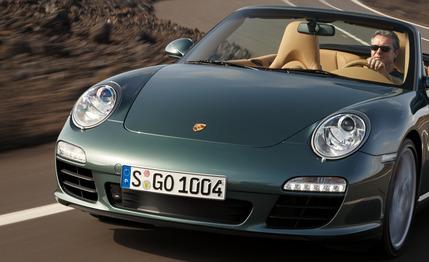 First Drive Review
First Drive Review
Despite Porsche’s grandiose maneuÂvering to take over Volkswagen, ÂEurope’s largest car company, the tiny Stuttgart automaker isn’t neglecting its core sports-car business. A perfect example is the 2009 version of the seminal 911 Carrera, known by anyone who matters as the 997.
The most important changes are in the engines: Both the standard 3.6-liter six and the 3.8-liter S version move from port to direct fuel injection. By injecting the fuel directly into the cylinder at a pressure of up to 1740 psi, the intake charge is cooled very effectively when the fuel atomizes. This allows the compression ratio to be increased to 12.5:1 and for a little more air to be sucked into the engine with each intake stroke. More air means more power, and higher compression aids both power and efficiency.
In addition, the construction of the water-cooled flat-six has changed to eliminate four major parts and improve cooling and stiffness. There’s also an improved lubrication system [see Tech Highlight] that lowers the engine 0.4 inch, along with a more compact intake manifold, lighter tappets, and bigger bore and shorter stroke dimensions.
As a result, horsepower in the 3614cc base engine jumps 20, to 345, and torque grows from 273 to 287 pound-feet. The 3800cc S engine goes from 355 to 385 ponies and from 295 to 310 pound-feet. The bigger increases in the S engine come from larger valves, greater valve lift, and a two-stage intake manifold.
Both engines come with the current six-speed manual, but for an extra $4080, a new PDK transmission can be ordered, replacing the previous Tiptronic option. This is a double-clutch gearbox with seven speeds, and it can operate automatically, in a variety of modes, or manually via the shift lever or switches on the steering wheel.
Top gear in the PDK gearbox is much taller than in either the six-speed manual or the old five-speed Tiptronic for lower rpm on the highway. European tests show the PDK to be about 12 percent more fuel efficient than last year’s Tiptronic and even thriftier than the manual.
Porsche says the PDK-equipped car accelerates to 60 mph a full second faster than the Tiptronic when coupled to the optional Sport Chrono package, which comes with launch control.
Other key additions to the ’09 models include a larger touch-screen LCD panel, standard bixenon headlights (with optional cornering function), LED taillights and daytime running lights, bigger front brake rotors and stiffer calipers on the base model, and an optional new PASM sport suspension that lowers the car 0.8 inch.
On back roads near Porsche headquarters in Germany, the new cars proved fantastic. Driven moderately, they’re comfortable and refined. Driven hard, they’re stirring and exhilarating, and make the driver feel as though he has Lewis Hamilton’s reflexes and car control.
Except for exhibiting a tiny hesitation when moving away from a stop, the PDK gearbox is as smooth as a torque-converter automatic, yet it has the tight connection between engine and rear wheels that makes a manual transmission so satisfying. Unfortunately, the PDK doesn’t ever relinquish full control to the driver. Even in the manual mode, the transmission will kick down and upshift at the redline if you mash the accelerator to the floor and hit the kickdown switch.
The shift controls on the steering wheel are also a bit odd, not being quite as convenÂient for upshifts as we’d like. But if the driver selects the “sport plus” mode, the PDK will slam the shifts hard and unfailingly select the correct gear for the circumstances.
Base prices for the new models, which arrive this month, range from $75,600 for a standard Carrera coupe to $96,800 for a Carrera S Cabriolet. Four-wheel-drive versions will follow shortly after. As always with Porsche, the prices are high, but if you can afford the cars, you won’t be disappointed.